Hola amigos - It is the rainy season in Venezuela, and right now it is raining hard!! So it's a good time to finish updating the web. We took a half day tour about a week after we arrived with Ken and Roberta on Second Wind. We went with Andreas who is a taxi driver here at Bahia Redondo. There are several taxi drivers here, and they just work with the cruisers. They take you wherever you need to go to get the best deals on supplies and they translate for you, they do day or half day tours as well. They are all very nice. We went with Andreas on this day, but we usually go with Raul when we need to go shopping for boat items.
 We started with a view from the top of Cerro el Morro looking back at the city of Puerto La Cruz and the marina Bahia Redondo. Andreas then took us through Puerto La Cruz and Barcelona. We travelled through Lecheria to Barcelona. Lecheria is a fair size city, but it used to be home to dairy farms - so the name Lecheria (leche is milk).
We started with a view from the top of Cerro el Morro looking back at the city of Puerto La Cruz and the marina Bahia Redondo. Andreas then took us through Puerto La Cruz and Barcelona. We travelled through Lecheria to Barcelona. Lecheria is a fair size city, but it used to be home to dairy farms - so the name Lecheria (leche is milk).We stopped at an art musuem in Lecheria. Casa Musueo Excultor Dimitrios Demu (Casa Museo is Home Museum). Dimitrios was a sculptor. He was born in Greece and imigrated to Romania in 1928. He
 left Romania in 1964 - going back to his homeland in Greece, then on to Venezuela in 1965. We were not allowed to take pictures in the museum, but we got a few before we found out. I tried to look him up on the internet, but only found the sites in spanish. You might want to look on the web and see if you can find something, he was a very interesting man. The work that made him famous as a sculptor in Bucharest was the statue of Stalin. He entered a contest to create
left Romania in 1964 - going back to his homeland in Greece, then on to Venezuela in 1965. We were not allowed to take pictures in the museum, but we got a few before we found out. I tried to look him up on the internet, but only found the sites in spanish. You might want to look on the web and see if you can find something, he was a very interesting man. The work that made him famous as a sculptor in Bucharest was the statue of Stalin. He entered a contest to create a sculptor of Stalin and won. Everything in the museum was created by Dimitrios. He also did paintings and stained glass. He was a big believer in UFO's and alien life forms and his work shows this.
a sculptor of Stalin and won. Everything in the museum was created by Dimitrios. He also did paintings and stained glass. He was a big believer in UFO's and alien life forms and his work shows this.
 Our next stop was Barcelona which is the capital of the state of Anzoategui. Barcelona has a population of 300.000 people. We went to Central Barcelona where they have several plazas and many buildings with colonial architecture. The historic quarter has been partly restored and whitewashed throughout and the architecture styles date from many different periods.
Our next stop was Barcelona which is the capital of the state of Anzoategui. Barcelona has a population of 300.000 people. We went to Central Barcelona where they have several plazas and many buildings with colonial architecture. The historic quarter has been partly restored and whitewashed throughout and the architecture styles date from many different periods.  The city's historic center, Plaza boyaca, has a statue of General Jose Antonio Anzoategui who was born Barcelona. General Anzoategui served under Bolivar. Bolivar achieved freedom for Venezuela and is greatly admired by all. Anzoategui was the one who freed Columbia. In every city in Venezuela you will find a plaza named Plaza Bolivar - it is rare to have any other plaza's named for other people, however, since Anzoategui was born in Barcelona and was highly regarded by Bolivar he is honored with a plaza and a statue.
The city's historic center, Plaza boyaca, has a statue of General Jose Antonio Anzoategui who was born Barcelona. General Anzoategui served under Bolivar. Bolivar achieved freedom for Venezuela and is greatly admired by all. Anzoategui was the one who freed Columbia. In every city in Venezuela you will find a plaza named Plaza Bolivar - it is rare to have any other plaza's named for other people, however, since Anzoategui was born in Barcelona and was highly regarded by Bolivar he is honored with a plaza and a statue.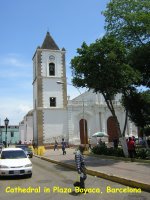
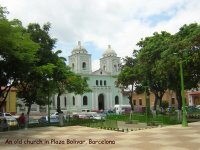 Overlooking the plaza is the cathedral built a century after the town's founding. There is also another church overlooking it (the light green one) but we did not get any history on that.
Overlooking the plaza is the cathedral built a century after the town's founding. There is also another church overlooking it (the light green one) but we did not get any history on that.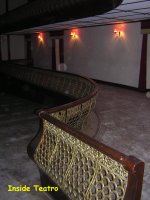
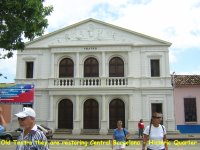 We did go into a Theatre (Teatro) that was being restored - it was built in the 1890's.
We did go into a Theatre (Teatro) that was being restored - it was built in the 1890's.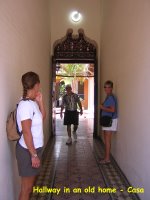 Andrea, our guide, grew up in this area of the city. He showed us a house similiar to his. You walk in a door, through a hallway to another door, where the people could look out and see who you were. Hundreds of years ago, if they saw you and youu were not friendly they could shoot you and you would have no way to escape, except down the hall. His house was very old. Inside the house, there are bedrooms that surround an outdoor patio and the kitchen was in the rear of the building to keep the heat out. The walls and floors are made of concrete which kept is amazingly cool inside. There was also a false roof in one room of the house, where they could hide, in the old days, from intruders or attackers.
Andrea, our guide, grew up in this area of the city. He showed us a house similiar to his. You walk in a door, through a hallway to another door, where the people could look out and see who you were. Hundreds of years ago, if they saw you and youu were not friendly they could shoot you and you would have no way to escape, except down the hall. His house was very old. Inside the house, there are bedrooms that surround an outdoor patio and the kitchen was in the rear of the building to keep the heat out. The walls and floors are made of concrete which kept is amazingly cool inside. There was also a false roof in one room of the house, where they could hide, in the old days, from intruders or attackers.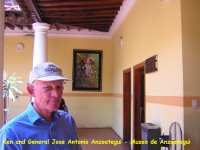 We visited the Museo de Anzoategui in the town's oldest building, it has objects
We visited the Museo de Anzoategui in the town's oldest building, it has objects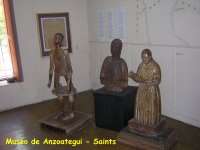 related to Barcelona's history. The picture to the left is Ken from Second Wind and the portrait behind him is General Anzoategui. The museum housed different cultural artifacts, but again we were not allowed to take pictures - but we got a couple in. The statues at the right are saints in the Catholic religions. The left most saint statue in the picture has bendable body parts. This would allow the women to dress a particular saint for religious ceremonies. The women that dressed the saints were women that had not married by the time they were 25 years old. If they had not married by then - they would not ever be married, so they dressed the saints......
related to Barcelona's history. The picture to the left is Ken from Second Wind and the portrait behind him is General Anzoategui. The museum housed different cultural artifacts, but again we were not allowed to take pictures - but we got a couple in. The statues at the right are saints in the Catholic religions. The left most saint statue in the picture has bendable body parts. This would allow the women to dress a particular saint for religious ceremonies. The women that dressed the saints were women that had not married by the time they were 25 years old. If they had not married by then - they would not ever be married, so they dressed the saints......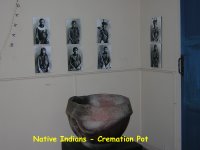 The other picture is of native indians. When they died they were burried close to their family dwelling. The indians believed that you went to purgatory before going to either heaven or hell. They believed it took up to ten years to get to either place, so they buried you for ten years. After those ten years they figured your soul had either gone to heaven or hell and you did not need your physical body anymore - so they dug you up and cremated you in a pot. The cremation pot you see in the picture was one that was actually used.
The other picture is of native indians. When they died they were burried close to their family dwelling. The indians believed that you went to purgatory before going to either heaven or hell. They believed it took up to ten years to get to either place, so they buried you for ten years. After those ten years they figured your soul had either gone to heaven or hell and you did not need your physical body anymore - so they dug you up and cremated you in a pot. The cremation pot you see in the picture was one that was actually used. Below are more pictures around the Plaza.
Below are more pictures around the Plaza.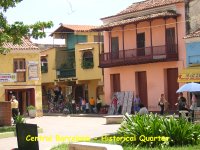
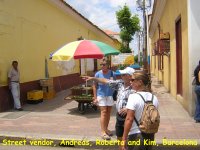
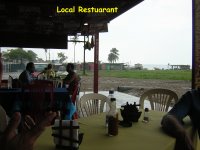 Our final stop for the day was lunch at a local restaurant. The restaurant is located just down the street from the marina. This is the last one in a row and there are approximately 12-14 little
Our final stop for the day was lunch at a local restaurant. The restaurant is located just down the street from the marina. This is the last one in a row and there are approximately 12-14 little restaurants under the same roof and they all serve the same thing, so the women stand out there and try to coax you into coming in to there spot. They are very nice about it, the ladies just stand out there whistling and motioning you to come over.
restaurants under the same roof and they all serve the same thing, so the women stand out there and try to coax you into coming in to there spot. They are very nice about it, the ladies just stand out there whistling and motioning you to come over. 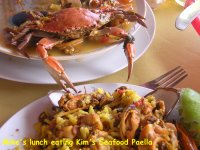 We went to one of the first ones and it was an experience. Mike had seafood soup and the rest of us had seafood Paella - Mike was the only one to finish his, ours was very fishy...there is another restaurant closer to
We went to one of the first ones and it was an experience. Mike had seafood soup and the rest of us had seafood Paella - Mike was the only one to finish his, ours was very fishy...there is another restaurant closer to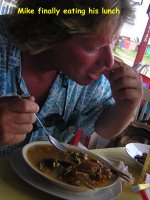 the marina that we have tried and it was very good. Kim ordered the fish and got a red snapper, whole except the eyes were gone, deep fried skin and all....she ate it all though it was very delicious. The little girl in the picture was quite a ham she was very happy to have here picture taken.
the marina that we have tried and it was very good. Kim ordered the fish and got a red snapper, whole except the eyes were gone, deep fried skin and all....she ate it all though it was very delicious. The little girl in the picture was quite a ham she was very happy to have here picture taken. 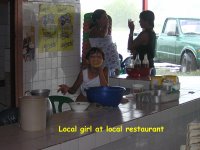
Chao from Bahia Redonda, Miguel and Kim on Ka'imi
No comments :
Post a Comment